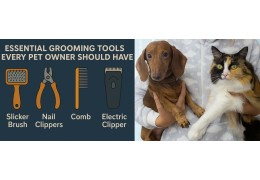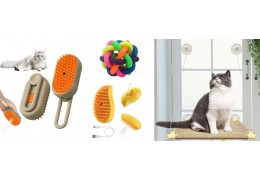Shedding is natural for pets, but it can quickly become overwhelming. This guide shares proven grooming tips, diet...
How to Prevent Shedding in Dogs and Cats: Pro Tips
Shedding is a natural process for both dogs and cats, but excessive fur around your home can be frustrating. While you can’t completely stop shedding, you can minimize it with the right grooming tools and care. Regular brushing with the best cat brush, using a high-quality cat comb, and maintaining a proper grooming routine with a reliable cat hair brush can significantly reduce loose fur.
By following expert techniques and using the best grooming tools, you can manage shedding effectively and keep your pet’s coat healthy while maintaining a cleaner home.
Why Do Dogs and Cats Shed?
Before tackling shedding, it’s important to understand why it happens. Shedding is a natural process that helps animals get rid of old or damaged fur and regulate body temperature. However, excessive shedding can be caused by:
• Seasonal Changes: Many pets shed more during spring and fall when their coats adjust to temperature shifts.
• Breed-Specific Traits: Some breeds, like Huskies and Maine Coons, shed more due to their thick undercoats.
• Poor Diet: A lack of essential nutrients can lead to excessive hair loss.
• Health Issues: Skin allergies, parasites, and stress can contribute to increased shedding.
By addressing these factors and incorporating regular grooming with the best cat brush or a cat comb, you can significantly reduce loose hair.
Pro Tips to Reduce Shedding in Dogs and Cats
1. Brush Your Pet Regularly
Brushing is the most effective way to control shedding. It removes loose fur before it falls onto your furniture, carpets, and clothes.
Choosing the Right Brush for Your Pet
• Short-haired cats and dogs: Use a soft cat hair brush or rubber grooming mitt to remove loose fur gently.
• Long-haired cats and dogs: A cat comb with wide and narrow teeth works best for detangling and preventing mats.
• Double-coated breeds: A de-shedding tool like the best cat brush removes excess undercoat fur efficiently.
Brushing Frequency
• Short-haired pets: Brush 2–3 times per week.
• Long-haired pets: Daily brushing is recommended.
• Heavy shedders: Use a de-shedding tool at least once a week.
Consistent grooming not only reduces shedding but also keeps your pet’s coat shiny and healthy.
2. Bathe Your Pet Regularly
Bathing helps loosen and remove dead fur while keeping your pet’s skin clean. However, overbathing can strip natural oils, leading to dry skin and more shedding.
Best Practices for Bathing
• Use pet-specific shampoo to keep skin moisturized.
• Bathe once a month for short-haired breeds and every two weeks for heavy shedders.
• Rinse thoroughly to prevent shampoo residue, which can cause irritation.
A post-bath brushing session with a cat hair brush helps remove any remaining loose fur.
3. Provide a Healthy Diet
A well-balanced diet plays a crucial role in controlling shedding.
Nutrients That Promote a Healthy Coat
• Omega-3 and Omega-6 fatty acids: Found in fish oil, flaxseed, and high-quality pet food, these nutrients keep fur strong and reduce excessive shedding.
• High-protein diet: Ensures a healthy coat and minimizes hair loss.
• Vitamin E and biotin: Support skin health and prevent dryness.
If shedding seems excessive, consult your vet about adding supplements to your pet’s diet.
4. Keep Your Pet Hydrated
Dehydration can cause dry skin, leading to excessive shedding. Make sure your pet has access to fresh water at all times. If your cat isn’t a big drinker, consider providing wet food or a pet water fountain to encourage hydration.
5. Reduce Stress Levels
Stress can cause excessive shedding in both cats and dogs. Common stressors include loud noises, changes in routine, and unfamiliar environments.
Ways to Reduce Stress
• Create a safe and quiet space for your pet.
• Stick to a consistent routine for feeding and playtime.
• Provide plenty of mental and physical stimulation to prevent anxiety.
Using a cat comb as part of a calming grooming routine can also help reduce stress-related shedding.
6. Control Fleas and Parasites
Skin irritation from fleas, ticks, and mites can lead to excessive scratching and hair loss. Keep your pet on a regular flea prevention plan to minimize shedding caused by skin irritation.
7. Use the Right Shedding Tools
Investing in high-quality grooming tools makes a big difference.
Must-Have Grooming Tools
• Best Cat Brush: Removes excess fur while being gentle on the skin.
• Cat Comb: Helps detangle knots and prevent matting in long-haired pets.
• Cat Hair Brush: Works well for daily grooming and keeping the coat smooth.
Using the right tools ensures a comfortable grooming experience for your pet.
8. Keep Your Home Clean
Even with proper grooming, some shedding is inevitable. Reduce fur buildup in your home by:
• Vacuuming frequently with a pet-friendly vacuum.
• Using furniture covers or lint rollers.
• Keeping pet bedding clean by washing it weekly.
When to See a Vet About Shedding
While shedding is normal, excessive hair loss can be a sign of an underlying health issue. Visit your vet if you notice:
• Bald patches or thinning fur
• Constant scratching or licking
• Red, inflamed skin
• Sudden increase in shedding
A vet can help determine if allergies, infections, or hormonal imbalances are causing the problem.
Final Thoughts
Shedding is a natural part of pet ownership, but with the right approach, it can be managed effectively. Regular grooming with the best cat brush, using a cat comb for long-haired pets, and maintaining a proper diet can all help minimize loose fur.
By following these pro tips, you can keep your dog or cat’s coat healthy while reducing shedding and maintaining a cleaner home. A consistent grooming routine using a cat hair brush will not only keep your pet looking great but also improve their overall health and well-being.












